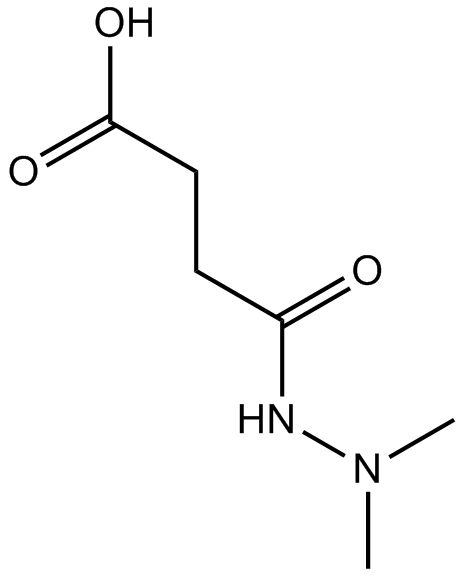Daminozide (Synonyms: Alar, Aminozide, B 995, DIMG, DMASA, Kylar, SADH, Succinic Acid) |
| Catalog No.GC15830 |
Selective inhibitor of KDM2/7 histone demethylases
Products are for research use only. Not for human use. We do not sell to patients.

Cas No.: 1596-84-5
Sample solution is provided at 25 µL, 10mM.
Daminozide, a plant growth regulator, selectively inhibits the KDM2A with IC50 value of 1.5 μM, PHF8 with IC50 value of 0.55 μM, KDM7A with IC50 value of 2 μM.[1]
FBXL11/KDM2A is a histone H3 lysine 36 demethylase enzyme which enzymatic activity relies on a conserved JmjC domain in the N-terminus of the protein that coordinates iron and alphaketoglutarate to catalyze demethylation via a hydroxylation based mechanism.[2] The ZF-CxxC DNA binding domain within FBXL11/KDM2A has the capacity to interact with non-methylated DNA and can target to CpG island regions of the genome where it specifically removes histone H3 lysine 36 methylation.[3] This mechanism acts to create a chromatin environment at CpG islands that highlights these regulatory elements and differentiates them from non-regulatory regions in large complex mammalian genomes. In a study in mouse hepatocytes, this gene was shown to regulate hepatic gluconeogenesis.[4]
Histone Nε-methyl lysine demethylases KDM2/7 have been identified as potential targets for cancer therapies. Lung cancer is the leading cause of cancer deaths in the United States and worldwide. Non–small cell lung cancer (NSCLC)accounts for about 85% of all lung cancer cases, and its molecular etiology is heterogeneous[5]. Klaus W. et al [6] found that KDM2A overexpression in NSCLC cells increased cell proliferation and invasiveness.And KDM2A knockdown abrogated tumor growth and invasive abilities of NSCLC cells in mouse xenograft models, suggesting that KDM2A may be a promising therapeutic target in NSCLC.Daminozide, as a KDM2A selective inhibitor, was once widely used as a plant growth retardant but now will be a potent approach to targeted therapies for NSCLC.[7]
References:
1.Nathan R. Rose. et al. Plant Growth Regulator Daminozide Is a Selective Inhibitor of Human KDM2/7 Histone Demethylases. Journal of Medicinal Chemistry. J. Med. Chem. 2012, 55: 6639−6643.
2.Tsukada Y. et al. "Histone demethylation by a family of JmjC domain-containing proteins". Nature 2006, 439 (7078): 811–6.
3.Blackledge NP. et al. "CpG islands recruit a histone H3 lysine 36 demethylase". Molecular Cell 2010, 38 (2): 179–90..
4.Pan D, Mao C. et al. "The Histone Demethylase Jhdm1a Regulates Hepatic Gluconeogenesis". PLOS Genetics,2012, 8 (6): e1002761.
5.Herbst RS, Heymach JV, Lippman SM. Lung cancer. N Engl J Med. 2008;359(13):1367–1380.
6.Klaus W.et al. KDM2A promotes lung tumorigenesis by epigenetically enhancing ERK1/2 signaling. J Clin Invest. 2013,123(12):5231-5246.
7.Sharma SV, Bell DW, Settleman J, Haber DA. Epidermal growth factor receptor mutations in lung cancer. Nat Rev Cancer. 2007;7(3):169–181.
Average Rating: 5 (Based on Reviews and 30 reference(s) in Google Scholar.)
GLPBIO products are for RESEARCH USE ONLY. Please make sure your review or question is research based.
Required fields are marked with *




















